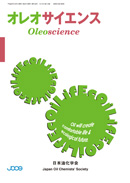All issues

Volume 3, Issue 5
Displaying 1-2 of 2 articles from this issue
- |<
- <
- 1
- >
- >|
-
Hisakazu MIHARA2003Volume 3Issue 5 Pages 233-239,232
Published: May 01, 2003
Released on J-STAGE: June 01, 2013
JOURNAL FREE ACCESSIntermolecular self-assembly of a large number of polypeptide chains into macromolecular constructs occurs widely in biological systems. One of such macromolecular self-assemblages of great interest is the amyloid fibril. The amyloid fibril is a misfolded and undesirable state for proteins as biomolecules, since it has been proposed to be a causative agent of a variety of diseases known as amyloid diseases, such as Alzheimer's and prion diseases. However, it is considered that the fibril has a highly-ordered tertiary structure, in which numerous β-stranded polypeptide chains align regularly. Thus this kind of fibril has the potential to be engineered into proteinaceous materials. Using peptides forming amyloid-like fibrils, peptide β-sheet arrays have been constructed to give self-assemblages composed of single, double, triple or quadruple different species. Moreover, the inhibitors that prevent the structural transition and formation of amyloid fibrils have been developed.View full abstractDownload PDF (1519K) -
Takeshi HASEGAWA2003Volume 3Issue 5 Pages 241-249,232
Published: May 01, 2003
Released on J-STAGE: June 01, 2013
JOURNAL FREE ACCESSInfrared spectroscopy is one of the most useful analytical tools to study molecular architecture and surface properties of thin films comprised of softmaterials. Thus far, however, the infrared spectroscopy has mainly been used for discussion of limited purposes such as investigations of semi-quantitative molecular orientation and of the state of hydrogen bonding formed in the film. In this manuscript, recent progress of infrared spectroscopy for studying thin softmaterials is presented, which is expected to have great potential to reveal new characteristics of the materials.View full abstractDownload PDF (1672K)
- |<
- <
- 1
- >
- >|